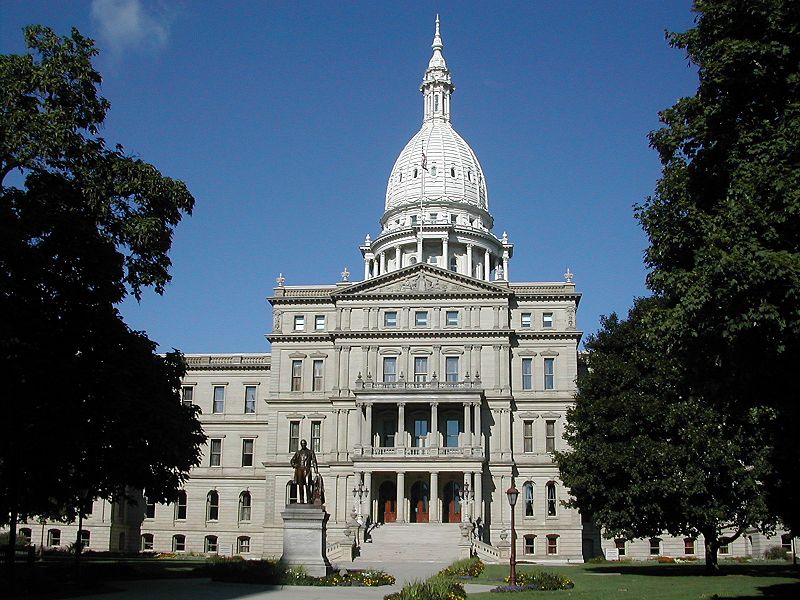Michigan State Capitol

The Michigan State Capitol is the building that houses the legal branch of the government of the U.S. state of Michigan. The present structure, at the intersection of Capitol and Michigan Avenues, is a National Historic Landmark that houses the chambers and offices of the Michigan Legislature as well as the ceremonial offices of the Governor of Michigan and Lieutenant Governor. Historically, this is the third building to house the Michigan federal government.
The first state capitol remained in Detroit, the original capital of Michigan, and was transferred to Lansing in 1847, due to the requirement to develop the state’s western portion and for much better defense from British soldiers stationed in Windsor, Ontario.
Michigan State Capitol Data
| General information | |
|---|---|
| Architectural style | Neoclassical/Italianate/Renaissance revival |
| Location | 100 N Capitol Ave, Lansing, Michigan, U.S. |
| Coordinates | 42.733601°N 84.555470°WCoordinates: 42.733601°N 84.555470°W |
| Groundbreaking | 1872 |
| Construction started | Cornerstone laid: October 2, 1873 |
| Completed | September 26, 1878 |
| Inaugurated | January 1, 1879 |
| Renovated | 1989–1992; 2010–2014 |
| Cost | $1,427,738.78 |
| Height | 267 feet (81 meters) |
| Dimensions | |
| Diameter | 128 m × 83.5 m (420 ft × 274 ft) |
| Technical details | |
| Lifts/elevators | 2 |
| Design and construction | |
| Architect | Elijah E. Myers |
Building
The Michigan State Capitol is 267 ft (81 m) from the ground to the suggestion of finial/spire above the dome. The structure is 420 ft 2 in (128.07 m) long and 273 ft 11 in (83.49 m) large (consisting of approaches). The capitol inhabits 1.16 acres (4,700 m2), has a boundary of 1,520 ft (460 m). The structure contains four stories, with public entryways on the ground floor. 2 grand staircases in the north and south corridors increase to the top floor. The rotunda measures 44.5 feet (13.6 m) in size and 160 feet (49 m) in height measured from the floor to the oculus.
When it opened, the Capitol structure was big enough to host all the state agencies and departments. Due to the development of state federal government, however, just the offices of Senate and House leadership and ritualistic offices for the guv and lieutenant guv remain in the capitol. Today, the ground flooring is home to numerous offices, including the Secretary of the Senate, the Clerk of the House, and the Capitol Tours and Information Service.
Beginning with the very first floor and continuing to the 3rd, black and white floor tiling is made from Vermont marble and limestone. The exception is the flooring of the rotunda which is composed of 976 blocks of clear glass, supported by iron beams and columns. It is a vault light, admitting light to the floor below. The blocks differ in size so that when viewed from the upper floors, they appear to form a bowl which mirrors the dome above.
The doorknobs are primarily made of a brass and bronze alloy (most of the initial brass doorknobs have vanished with time). Today doorknobs and hinges, locked for security, display the state coat of arms. The structure appears to have walnut woodwork, the wood is Michigan white pine that has actually been wood-grained to give the look of walnut.
The very first floor offers visitors their very first view of the interior of the rotunda. For more than a century, the muses’ artist stayed confidential; it is now understood that it was Tommaso Juglaris, who developed them in his Boston studio and never came to Michigan. In the east wing of the very first flooring is a big clock, called a long-drop clock.
The 2nd flooring, in addition to housing the gubernatorial workplaces, features the Gallery of Governors with pictures of former Michigan Governors on the walls of the rotunda; the gallery extends up to the 3rd floor. The previous chambers of the Michigan Supreme Court are in the south wing of the structure. The court vacated its chambers in 1970 for larger quarters, eventually moving to its present place in the Michigan Hall of Justice.
Public access to Michigan’s legislative bodies is through the third floor. The capitol building holds the chambers and offices of the bicameral state legislature, which is composed of the Michigan House of Representatives and Michigan Senate. Senate and House sessions are taped by Michigan Government Television, a public service body transmitted to local cable television systems’ government-access tv channels.
Although having the exact same floor plan, your house and Senate chambers are decorated extremely differently, with the former in terra cotta and teal colors and the latter in blue and gold. An oval cartouche in the carpet at the entryway to your home chamber features the state flower, the apple blossom. Presiding over your home is the speaker, whose chair is behind a desk in the center with a plaster and paint variation of the state coat of arms. The Senate chamber is somewhat smaller sized than the House. The president of the Senate is the lieutenant governor, who commands sessions from a walnut rostrum at the front of the chamber. Both the House and the Senate use computerized voting systems, consisting of wall-mounted screens that permit visitors to follow the voting and both also contain glass tiled ceilings that enable natural light to shine through etched glass panels to better light the space. These ceiling tiles feature the coats-of-arms of each state in the United States.
In summer 2013, the structure went through extra work to replace carpets installed in the 1989– 1992 remodelling that had become worn and torn in lots of areas. Work also updated circuitry for communications systems, fixed roof leakages and upgraded a disabled parking area and entrance on the north side. Lansing Michigan Information.

